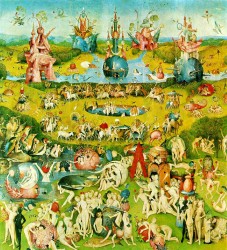
Lindberg 1972
“The fire next time” (Bo Lindberg) 1972
[In: Journal of the Warburg and Courtauld Institutes, vol. 35 (1972), pp. 187-199]
[Also mentioned in Gibson 1983: 92 (E113)]
Works of art from the Middle Ages or the Renaissance often have a double or even a multiple meaning. The more complex the work of art, the more often we forget that more than one level of meaning can play a part in the interpretation and besides we often don’t pay attention to the literal meaning. The question now is: does the Garden of Delights have a literal meaning that unites the four parts and that can be recognized without key to the complete symbolism? Gombrich has suggested that the closed wings, the left interior panel and the central panel are based on one idea: the lesson of the Flood. Does the right interior panel (Hell) fit in with this theme?
The Flood is a prefiguration of the Last Judgment. In the first case the earth was destroyed by water, in the second case the world will be destroyed by fire. Lindberg then refers to II Peter 3: 5-7, in which passage verse 5 refers to the earth that God has created and that rises from the water (see the closed wings of the Garden) whereas verse 6 refers to the antediluvian world (which is shown in the central panel) that was destroyed by the Flood and verse 7 refers to the world as it is now, the world that will be destroyed by fire when the Last Judgment arrives. Could it be possible that the right interior wing shows this Last Judgment?
Apart from the title Sicut erat in diebus Noe the inscription in the closed wings also offers a key for the literal meaning of the triptych. This biblical quotation can be found in Psalm 32: 9, Psalm 148: 5 and Judith 16: 17. This text perfectly matches a triptych showing the judgment over the sinners and at the same time offering a complete history of the world from Creation to Last Judgment. Something similar is the case in Schedel’s Buch der Croniken (a popular work before 1500) with the same quotation on its title page.
Gombrich has demonstrated that the black people in the central panel may be descendants of Cain. Lindberg suggests that it is also possible that before the Flood there were people with hair all over their body, but he has not found definitive proof for this. The world as it was in the days of Noe is turned into a parable about the ‘modern’ world by Bosch. It is very probable that the only man with clothes on (in the bottom right corner of the central panel) is Noe. Lindberg agrees with Gombrich: the closed wings represent the world after the Flood.
The Church Fathers interpreted the biblical quotation in the closed wings as a reference to the fact that God created the world by means of the Word, and this Word was the Son: that is why He is shown in the left interior panel. The dogma that God the Father and God the Son are one person (the Father invisible, the Son visible) was depicted by Bosch by painting the Father and the Son in two different places with slightly altered faces and attributes (and moreover: the invisible Father outside the created world).
Now what is the literal meaning of the triptych? In the closed wings we see God outside the world He created by means of the Word, Christ, who Himself has just created Eve in the left interior panel. Underneath the earth in the closed wings we see the water that will destroy the earth during the Flood. The people in the central panel are not really bad or aggressive, but they don’t honour God and they are not grateful to Him and that is why they are not aware of the ocean under their feet that will soon destroy them. The people who are still living without God today will also be destroyed, but this time by fire, as is shown in the right interior panel. The triptych as a whole has got a double meaning. The closed wings represent the world on the third day of Creation ànd the world after the Flood. The left interior panel represents Eden before ànd after the Fall of Man (creation of Eve / aggressive animals). The central panel represents the world in the days of Noe ànd as it is now. The right interior panel represents the world as it is now ànd as it will be during the Last Judgment.
Although this article offers some interesting ideas, Lindberg’s interpretation as a whole can only be called laborious and little convincing.
[explicit]